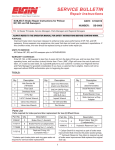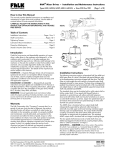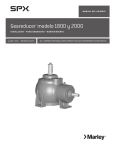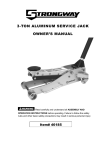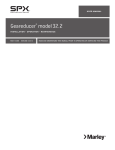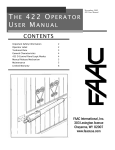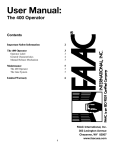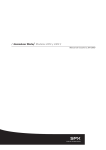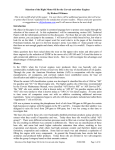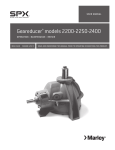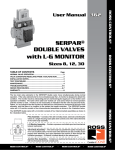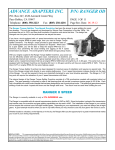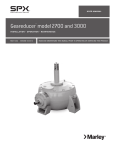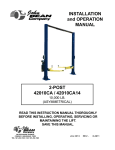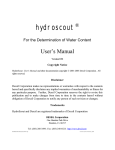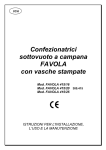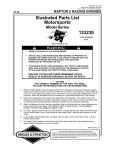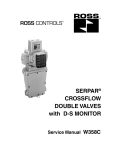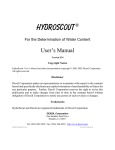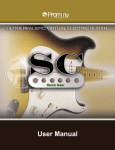Download Marley Cooling Tower Geareducer Model 34.4 and 3400 User Manual
Transcript
® / Marley Geareducer Model 34.4 and 3400 / User Manual 01-1162B Operation and Service Instructions Protection Against Corrosion Seasonal Shutdown one week to three months As shipped, a Marley Geareducer is protected internally against corrosion with machine enamel on unmachined parts and with rust-proofing oil and grease on machined surfaces. These coatings normally protect the Geareducer against atmospheric corrosion for storage periods up to six months. However, if oil is added to the Geareducer, it will dissolve the rust-proofing grease and oil, requiring the Geareducer to be run once a week to keep a protective coating of oil on all interior machined surfaces. See “Seasonal Shutdown” section for information about nonoperating period maintenance. At start of shutdown period, operate Geareducer until oil is warm—120°F (50°C)—and change the oil. See section on Service and Lubrication. Check Geareducer exterior yearly. Touch up with paint as required. Exposed pipe threads are coated to prevent corrosion. Touch up coating as required. For longer periods of shutdown, see Marley Manual 92-1308 “Downtime Instruction Manual”. Initial Operation The Geareducer must be filled with oil to the full oil level mark on the Geareducer case before it is placed in operation. See Service and Lubrication section for oil filling instructions. Each month drain any water condensation from the lowest point of the Geareducer and its oil system. Check the oil level and add oil if necessary. Operate the Geareducer long enough to recoat all the interior surfaces with oil. To put back into operation, drain water condensation and check oil level. Add oil if necessary. Inspection Of Internal Parts Remove the inspection cover plate from the side of the Geareducer case at each oil change. Check inside of Geareducer for cleanliness of case and internal parts. If any sludge is present, flush inside of Geareducer and connecting oil line. Geareducers supplied with new towers include oil for the initial filling. Oil is not furnished with Geareducers supplied as spares or on replacement orders. Before operating the mechanical equipment, check to be sure the oil level is at the full mark at the Geareducer and that the external gauge placard full mark corresponds with the “Full” level in the Geareducer. Check oil lines to be sure there are no leaks. Service and Lubrication Geareducer vent or vent line must be open to prevent failure of pinion shaft oil seal—clean when necessary. Check all gasketed joints for oil seepage. Tighten cap screws and flange bolting if necessary. Fill the Geareducer and oil line system with oil, using one of the following procedures: The Geareducer must be installed level and properly aligned with drive shaft and motor shaft. Refer to the Driveshaft User Manual. 1. Install oil at the opening at the Geareducer inspection cover until it reaches the level of the “Full” mark on the Geareducer case and at the oil level gauge. See Figures 1 and 2. Install plug. The horizontal part of the oil line must be level or slightly lower at the oil level gauge than at the Geareducer. The oil capacity of the Geareducer is 181⁄2 gallons. The oil level gauge line requires approximately one gallon of additional oil. Refer to Table 1 on page 5 for list of suggested lubricants. Recommended procedure: 2. Start the fan drive and run for one minute. 3. Stop the fan drive. Allow ten minutes for oil level to stabilize and recheck oil level at the Geareducer. 4. If necessary, repeat steps 2 and 3 until stabilized oil level is at the proper level. 5. Check gauge placard location. “Full” mark on the placard must be at the same elevation as the “full” mark at the Geareducer. 2 Operation and Service Instructions Alternate procedure: The cooling tower has an external oil gauge and drain line equipped with a three-way valve below the oil level gauge. See Figure 1. 1. Remove pipe plug. Turn valve control stem clockwise to open drain. 2. With Geareducer drained, the three-way valve turned clockwise, and the pipe plug removed, connect fill source (usually a hose to a pump, to the three-way valve). Pump oil through the hose. Check oil level occasionally by turning the valve control stem counterclockwise and allowing the oil level in the sight glass to stabilize. Continue filling until full level mark is reached. 3. With the oil level at the full mark turn the valve control stem counterclockwise to close the drain and open the valve to the sight glass. Remove the oil filling line and reinstall pipe plug in the three-way valve. VENT LINE Maintenance of the Geareducer should be scheduled as follows: Monthly: Check oil level at least once a month using the following procedure: Stop the fan drive. Allow ten minutes for oil level to stabilize and check oil level at the gauge. If needed, add oil to Geareducer. If oil is added, repeat steps 2 and 3 of recommended procedure until stabilized oil level is at the proper height. Semi-Annually: Change oil at least every 6 months or 3,000 hours of operation. Refer to recommended oil change procedure. Check the oil level placard location each time the oil is changed. The “Full” mark on the placard must be at the same elevation as the “Full” arrow on the side of the Geareducer case. See Figures 1 and 2. Oil level gauge vent must be kept open. Inspect at each oil change and clean when necessary. Inspect internal parts and inside of Geareducer case at each oil change—see section on inspection of internal parts. OIL LEVEL CHECK OIL FILL PLUG INSPECTION COVER OIL GAUGE VENT OIL LEVEL GAUGE DRAIN PLUG OIL GAUGE AND DRAIN LINE THREE-WAY VALVE Figure 1 Service Fittings 3 Operation and Service Instructions Repair and Overhaul VENT OIL LEVEL PLACARD NOTICE CHECK OIL LEVEL TEN MINUTES AFTER FAN STOPS ROTATING FULL ADD OIL OIL LEVEL GAUGE FILL AT GEAREDUCER REFER TO SERVICE MANUAL FOR OIL CHANGE AND MAINTENANCE RECOMMENDATIONS SPX COOLING TECHNOLOGIES OVERLAND PARK, KS USA 92-110A If your Geareducer ever needs replacement or repair, SPX recommends returning the unit to a Marley factory service center. Contact your Marley sales representative to discuss a course of action. A factory reconditioned Geareducer carries a one year warranty. The Marley Order Number on your cooling tower will be required if the Geareducer is shipped back to the factory for repair. Obtain a “Customer Return Material” tag from the Marley sales representative in you area. To find your Marley sales representative call 913 664 7400 or check the internet at spxcooling.com. Major repairs require the use of a fully equipped machine shop. If you decide to repair or overhaul your Geareducer, refer to the Field Repair Section and Geareducer Parts List. Suggested Lubricants Figure 2 Oil Level Gauge Assembly Maintenance Service The following list of lubricants—Table 1—is provided as reference only. These products have been recommended by their respective manufacturers as acceptable for use in a Marley spiral bevel and/or helical Geareducer for cooling tower applications. This list is not an attempt to include all the lubricants that may be satisfactory. If lubricants other than those listed are used they must not contain any additives—such as detergents or EP additives—which are adversely affected by moisture and could reduce the service life of the Geareducer. Suitability of lubricants used other than those listed rests with the customer/owner and lubricant supplier. Monthly Semi-annually Seasonal Startup or Annually x x Geareducer Drive: Inspect and tighten all fasteners including oil plug Check for and repair oil leaks x x x Check oil level x R x Change oil R R Make sure vent is open x x Check driveshaft or coupling alignment x Inspect and tighten driveshaft or coupling fasteners x Check driveshaft or coupling bushing / flex elements for unusual wear x Lube Lines (if equipped) Check for oil leaks in hoses and fittings x R x R – Refer to instructions within this manual Note: It is recommended at least weekly, that the general operation and condition be observed. Pay particular attention to any changes in sound or vibration that may signify a need for closer inspection. 4 Operation and Service Instructions Manufacturer Product Amoco American Industrial Oil 100 Marathon Ashland Endurance R & O Oil 100 BP Turbinol T-100 Century Renolin RO 100 Citgo Pacemaker 100 Exxon Teresstic 100 Lubrication Engineers Monolec 6404 Mobil Mobil DTE Oil 100 Mobil Mobil SHC629* Penzoil Pennzabell PB100 or RO100 Phillips 66 Magnus 100 Shell Turbo T-100 Sun Sunvis 9100 Texaco Regal Oil R&O 100 Unocal (east) Unax RX100 Unocal (west) Turbine Oil 100 Valvoline Valvaline R & O 100 *This synthetic product may be applicable for high temperature service or extended oil life Table 1 5 Parts List-3400 304 305 303 WATER SLINGER INTERSTAGE BEARING CAP 703 204 – 206 500 LABYRINTH RING 500 AIR VENT 202 412 603 422 20 – DOWEL PIN GEAREDUCER CASE COVER 302 5 – INTERSTAGE BEARING RETAINER FAN SHAFT 301 101 – SPIRAL BEVEL RING GEAR 306 109 201 106 201 40 INTERSTAGE SHAFT 421 411 203 205 101 – PINION SHAFT AND GEAR 500 102 INSPECTION COVER 105 702 PINION CAGE 401 104 PINION CAGE CAP 602 GEAREDUCER CASE Figure 3 Model 3400 Exploded Assembly 6 402 103 701 601 23 Parts List-3400 1 Complete Geareducer Assembly. 100 Spiral Bevel Gear Set. 101 Set of matched spiral bevel gears including integral pinion shaft with key. Gear ratios as follows: 2.76 to 1 2.375 to 1 2.476 to 1 102 Oil slinger. 103 Locknuts. 104 Lockwasher. 105 Pinion shaft key. 106 Interstage shaft key. 108 Thick ring gear spacer. 109 Thin ring gear spacer. 200 Helical Gear Set. 201 Set of matched helical gears including interstage shaft and special key Gear ratios as follows: 4.182 to 1 4.70 to 1 202 Top interstage bearing retainer disc. 203 Bottom interstage bearing retainer disc. 204 Place bolts. 205 Place bolts. 206 Washers. 300 Fan Shaft Assembly. 301 Fan shaft. 302 Key. 303 Fan hub retainer. 304 Cap screw. 305 Locking plates. 306 Key. 400 Pinion Shaft Bearing Set 401 Tail, tapered roller bearing 402 Head, tapered roller bearing 410 Interstage Bearing Set 411 Lower, double row, tapered roller bearing. Matched assembly with cone spacer 412 Upper, double row, tapered roller bearing. Matched assembly with cup spacer 420 Fan Shaft Bearing Set 421 Lower tapered roller bearing 422 Upper tapered roller bearing 500 Shim set 501-502-503 Pinion shaft shims 504-505-506 Interstage shaft shims 507-508-509 Fan shaft shims 600 700 Gasket Set 601 Pinion cage gasket 602 Inspection cover gasket 603 Oil trough gasket O-Rings Set. 702 Pinion cage O-ring, 93⁄4" ID" × 10" OD × 1⁄8" 703 Water slinger O-ring, 61⁄2" ID × 63⁄4" OD × 1⁄8" 701 Pinion Shaft Oil Seal 7 Parts List-34.4 304 305 303 WATER SLINGER INTERSTAGE BEARING CAP 307 204 – 206 500 703 LABYRINTH RING 202 AIR VENT 412 603 422 20 – DOWEL PIN GEAREDUCER CASE COVER 302 5 – INTERSTAGE BEARING RETAINER FAN SHAFT 301 108 306 101 – SPIRAL BEVEL RING GEAR 109 201 106 201 40 INTERSTAGE SHAFT 411 203 205 101 – PINION SHAFT AND GEAR 500 102 INSPECTION COVER 105 702 PINION CAGE 401 104 PINION CAGE CAP 602 421 DRAIN PLUG Figure 4 Model 34.4 Exploded Assembly 8 402 GEAREDUCER CASE 500 704 LOWER FAN SHAFT CAP 103 701 601 23 Parts List-34.4 1 Complete Geareducer Assembly. 100 Spiral Bevel Gear Set. 101 Set of matched spiral bevel gears including integral pinion shaft with key. Gear ratios as follows: 2.76 to 1 2.375 to 1 2.476 to 1 102 Oil slinger. 103 Locknuts. 104 Lockwasher. 105 Pinion shaft key. 106 Interstage shaft key. 108 Thick ring gear spacer. 109 Thin ring gear spacer. 200 Helical Gear Set. 201 Set of matched helical gears including interstage shaft and special key Gear ratios as follows: 4.182 to 1 4.70 to 1 202 Top interstage bearing retainer disc. 203 Bottom interstage bearing retainer disc. 204 Place bolts. 205 Place bolts. 206 Washers. 300 Fan Shaft Assembly. 301 Fan shaft. 302 Key 303 Fan hub retainer. 304 Cap screw. 305 Locking plates. 306 Key 307 Water slinger spacer. 400 Pinion Shaft Bearing Set 401 Tail, tapered roller bearing 402 Head, tapered roller bearing 410 Interstage Bearing Set 411 Lower, double row, tapered roller bearing. Matched assembly with cone spacer 412 Upper, double row, tapered roller bearing. Matched assembly with cup spacer 420 Fan Shaft Bearing Set 421 Lower tapered roller bearing 422 Upper tapered roller bearing 500 Shim set 501-502-503 Pinion shaft shims 504-505-506 Interstage shaft shims 507-508-509 Fan shaft shims 600 700 Gasket Set 601 Pinion cage gasket 602 Inspection cover gasket 603 Oil trough gasket O-Rings Set. 702 Pinion cage O-ring, 93⁄4" ID" × 10" OD × 1⁄8" 703 Water slinger O-ring, 61⁄2" ID × 63⁄4" OD × 1⁄8" 704 Lower fan shaft cap O-ring. 701 Pinion Shaft Oil Seal 9 Field Repair General Geareducers can be repaired in the field—however, major repairs require the use of a fully equipped machine shop. When field repair or replacement of parts is necessary, the following procedure is recommended for the disassembly and assembly of the unit. If any O-ring, oil seal or gasket is to be reused, care should be taken not to damage it during disassembly. Parts which contain O-rings or seals should not be jerked or twisted past a shoulder or edge. These parts are marked with an asterisk (*) in the description below. O-rings, oil seal and gaskets should be carefully inspected for damage before being reinstalled. SPX recommends that new O-rings and oil seal be installed during every major overhaul. 2 3* 4 5 5 Disassembly of Major Subassemblies Part numbers and references—refer to Figures 3 thru 6. 1. Drain oil. 2. Remove interstage bearing cap. 3. Pull water slinger off fan shaft.* 4. Lift off Geareducer case cover. 5 5. Pull interstage shaft and fan shaft subassemblies out of Geareducer case simultaneously. 6. Remove pinion cage subassembly.* 7. Remove lower fan shaft cap (34.4 only). 6* Figure 5 Model 3400. Disassembly of Major Subassemblies 10 Field Repair 2 3* 4 5 5 5 6* 7 Figure 6 Model 34.4. Disassembly of Major Subassemblies 11 Field Repair 5 4 3 4 2 1 Figure 7 Disassembly of Pinion Cage Disassembly of Pinion Cage 1 5 Part numbers and references—refer to Figures 3, 4 and 7. 1. Remove pinion cage cap. Model 3400–Remove rotating portion of oil seal (701). 2. Remove locknuts (103) and washer (104) from pinion shaft. 3. Press pinion shaft with head bearing cone (402) out of pinion cage. This will free cone of tail bearing (401). 4. Remove bearing cups from pinion cage. 5. If bearing cone on head of pinion shaft is to be replaced, it will be necessary to press off oil slinger (102) and bearing cone at the same time. 3 4 Disassembly of Interstage Part numbers and references—refer to Figures 3, 4 and 8. 1. Remove top and bottom interstage bearing discs (202 and 203). 2. Pull bottom bearing (411), two cones with spacer and one cup from shaft. 2 3. Push shaft out of upper bearing (412) and retainer. 4. Remove spiral bevel ring gear and spacers from shaft. 5. Pull upper bearings from top interstage retainer (5). 1 Figure 8 Disassembly of Interstage 12 Field Repair Instructions Disassembly of Fan Shaft Part numbers and references—refer to Figures 3, 4 and 9. 1. Press helical ring gear (201), lower fan shaft spacer (40) and lower cone (421) from shaft. Remove key spacer ring. 2 2. Remove upper bearing cone (422)and water slinger spacer (703). 1 3. Remove upper fan shaft bearing cup (422) from case cover (not illustrated). 4. Remove lower fan shaft bearing cup (421) from case (not illustrated). Assembly of Geareducer Gear Match Numbers and Setting Data Figure 9 Disassembly of Fan Shaft Before assembling a new pinion gear in the pinion cage, check match numbers on pinion gear and spiral bevel ring gear to be certain they are a matched set. Gears are lapped in matched sets at the factory and should not be separated. Numbers are etched on both the pinion and ring gear as illustrated in Figure 10. Pinion Cage Assembly Part numbers and references—refer to Figures 3, 4 and 11. 1. Press oil slinger (102) onto pinion shaft. 2. Install pinion head bearing cone (402) on pinion shaft. 3. Press pinion head bearing cup (402) into pinion cage. 4. Press pinion tail bearing cup (401) into pinion cage. MATCHED NUMBER TO BE COMPARED WITH THE SAME NUMBER ON THE RING GEAR. (EXAMPLE CO-43) PINION SETTING DISTANCE. (EXAMPLE 4.860) BACKLASH (NORMAL) AT WHICH THE GEARS WERE LAPPED. (EXAMPLE .010) MATCHED NUMBER TO BE COMPARED WITH THE SAME NUMBER ON THE PINION GEAR. (EXAMPLE C0-43) THE PINION SETTING DISTANCE IS THE DISTANCE THE END OF THE PINION SHOULD BE FROM THE CENTERLINE OF THE RING GEAR SHAFT. Figure 10 Gear Match Numbers and Setting Data 5. Lower pinion cage over pinion shaft until head bearing cone (402) mates with cup. 6. Press tail bearing cone (401) onto pinion shaft. a–Lock with lock nuts (103) and lockwasher (104) to provide bearing preload of 10 to 18 in·lbƒ (1130-2034 mN·m) resistance to rotation of pinion shaft. b–Crimp ears of lockwasher (104) to locknuts after obtaining prober preload. 7. Model 3400. Slide oil seal (701) onto pinion shaft. Model 34.4. Press oil seal (701) in pinion cage cap. 8. Assemble pinion cage cap to pinion cage with gasket (601) or RTV. Tighten bolts (23) to 55 ft·lbƒ (75 N·m) torque. Model 3400. Make sure rotating seal member magnetically engages stationary element in cap. 13 Field Repair Instructions 1 2 3 5 4 6 7 8 6B Figure 11 Pinion Cage Assembly 11 10 5 9 Interstage Assembly Part numbers and references—refer to Figures 3, 4 and 12. 1. Install thin spiral bevel ring gear spacer (109) against top of helical pinion. Install key (106) and spiral bevel ring gear (101) on interstage shaft. 7 6 8 2. Press top cone of bottom interstage bearing (411) onto interstage shaft. 3. Install double cup and spacer of bottom interstage bearing (411). 1 4. Press bottom cone (411) into place. 5. Install retainer disc (203) with bolts. Tighten to 55 ft·lbƒ (75 N·m) torque. 6. Install thick spacer (108) on interstage shaft on top of spiral bevel gear hub. 5 Figure 12 Interstage Assembly 14 2 7. 3 8. Lower retainer (5) over interstage shaft. 4 9. Press upper bearing cones (412) onto shaft. Press lower cup of upper interstage bearing into retainer (5). 10. Press upper cup (412) and spacer into retainer (5). 11. Install disc (202) with place bolts. Tighten to 150 ft·lbƒ (204 N·m) torque. Field Repair Instructions 4 1 2 3 3. Lower fan shaft and interstage shaft subassemblies into case simultaneously. Engage marked spiral bevel ring gear teeth with marked spiral bevel pinion tooth. The gear and pinion are match-marked when lapped and must be assembled the same way. The ring gear has the end of two teeth marked “X” and the pinion has one tooth so marked— the gears should be engaged with the X-marked pinion tooth between those marked on the ring gear. Match mark location can be checked through the inspection opening. 4. Apply a coat of Permatex® Form-a-Gasket No. 2 to surface of Geareducer case which mates with case cover. Lower case cover subassembly onto case, piloting both shaft subassemblies into their respective bores. 5. Install dowel pins (20) to align bearing bores. Fasten case cover to case with cap screws tightening to 75 ft·lbƒ (102 N·m) torque. Figure 13 Fan Shaft Assembly 6. Position top interstage cap shims (500) and install interstage bearing cap with place bolts tightening to 85-90 ft·lbƒ (116122 N·m) torque. 7. Fan Shaft Assembly Part numbers and references—refer to Figures 3, 4 and 13. 1. Install key (306) and press helical gear (201) on fan shaft. 8. Fan shaft bearing must be preloaded to .001–.003" (.025– .076mm) in the following manner: a–Install labyrinth ring with sufficient quantity of shims (500) to insure axial bearing endplay exists. b–Mount a dial indicator to measure axial movement of fan shaft. Support indicator stand on the cover or interstage cap adjacent to fan shaft and position indicator to read on machined top surface of fan shaft c–Rotate the fan shaft slowly in one direction until all downward movement stops. Rotation is necessary to align the bearing rollers and seat roller ends on cone lip. Record the dial indicator reading or zero the indicator. d–Move shaft in the opposite axial direction by attaching to the shaft with a swivel joint and hoist or by turning Geareducer over, allowing the weight of the shaft assembly to seat the bearings. If a hoist is used, the lifting force should be 800 lb (363 kg) to sufficiently overcome the weight of the fan shaft assembly. Rotate the shaft slowly in one direction until all axial movement stops. Record the dial indicator reading. e–The difference in dial indicator readings (steps c and d) is the initial fan shaft bearing end play. In order to achieve 2. Install lower bearing spacer (40) on fan shaft. 3. Press bottom bearing cone (421) onto fan shaft. 4. Press upper bearing cone (422) on fan shaft. Model 34.4 – Install water slinger spacer (307) on top of bearing cone. 5. Install lower fan shaft bearing cup (421) into Geareducer case (not illustrated). 6. Install upper fan shaft bearing cup (422) into Geareducer case cover (not illustrated). Final Assembly–Model 3400 Part numbers and references—refer to Figures 3 and 14. 1. Install O-ring (702) onto pinion cage subassembly. 2. Bolt pinion cage subassembly to case using proper number of shims to give indicated pinion setting distance which is etched on front face of pinion gear. See Figure 10. Tighten to 75 ft·lbƒ (102 N·m) torque. Adjust shims to give proper backlash—.007–.009" normal (.178–.228mm)—between spiral bevel gears. See Gear Setting Procedure, page 18. ➠ 15 Field Repair Instructions 8 the prescribed preload of .001" to .003" (.025–.076mm) remove an amount of shims from between the case and labyrinth ring equal to the measured end play plus .001" to .003". For example if the measured end play is .005" (.127mm), remove a total of .006 to .008" (.152–.203mm) in shim thickness. 6 8 f–Tighten labyrinth ring cap screws to 35 ft·lbƒ (48 N·m) torque. g–Fill grooves of labyrinth ring and water slinger with lithiumbase grease of NLGI No. 2 consistency. h–Install water slinger and its O-ring (703) on fan shaft. 9. Install inspection cover, gasket (602), and pipe plugs. 5 4 3 Final Assembly–Model 34.4 Part numbers and references—refer to Figures 4 and 15. 1. Install O-ring (702) onto pinion cage subassembly. 2. Bolt pinion cage subassembly to case using proper number of shims to give indicated pinion setting distance which is etched on front face of pinion gear. See Figure 10. Tighten to 75 ft·lbƒ (102 N·m) torque. 3 3. Temporarily install lower fan shaft cap and secure to case with cap screws. Leave a minimum of 1⁄8" (3mm) clearance between cap and case. Do not install O-rings or shims at this time. 3 4 1 4. Lower fan shaft and interstage shaft subassemblies into case simultaneously. Engage marked spiral bevel ring gear teeth with marked spiral bevel pinion tooth. The gear and pinion are match-marked when lapped and must be assembled the same way. The ring gear has the end of two teeth marked “X” and the pinion has one tooth so marked— the gears should be engaged with the X-marked pinion tooth between those marked on the ring gear. Match mark location can be checked through the inspection opening. 2 9 Figure 14 Model 3400 Final Assembly 16 Field Repair Instructions 5. Apply a coat of Permatex® Form-a-Gasket No. 2 to surface of Geareducer case which mates with case cover. Lower case cover subassembly onto case, piloting both shaft subassemblies into their respective bores. 11 7 6. Install taper pins (20) to align bearing bores. Fasten case cover to case with cap screws tightening to 45 ft·lbƒ (61 N·m) torque. 10 6 7. a–Position top interstage cap shims (500) and install interstage bearing cap with place bolts. b–Adjust shims to give proper backlash—.006–.012" normal (.152–.305mm)—between spiral bevel gears. See Gear Setting Procedure, page 18. c–When proper backlash has been set, tighten place bolts to 90 ft·lbƒ (122 N·m) torque. 5 8. Fan shaft bearing must be preloaded to .001–.003" (.025– .076mm) in the following manner: 4 a–Initially install a quantity of shims between case and bottom cap to insure that axial bearing end play exists. b–Mount a dial indicator to measure axial movement of fan shaft. Support indicator stand on the cover or interstage cap adjacent to fan shaft and position indicator to read on machined top surface of fan shaft. c–Rotate the fan shaft slowly in one direction until all downward movement stops. Rotation is necessary to align the bearing rollers and seat roller ends on cone lip. Record the dial indicator reading or zero the indicator. d–Move shaft in the opposite axial direction by attaching to the shaft with a swivel joint and hoist or by turning Geareducer over allowing the weight of the shaft assembly to seat the bearings. If a hoist is used, the lifting force should be 700 lb (317 kg) to sufficiently overcome the weight of the fan shaft assembly. Rotate the shaft slowly in one direction until all axial movement stops. Record the dial indicator reading. 4 4 12 5 ➠ 9 1 8 2 3 Figure 15 Model 34.4 Final Assembly 17 Field Repair Instructions e–The difference in dial indicator readings (steps c and d) is the initial fan shaft bearing end play. In order to achieve the prescribed preload of .001 to .002" (.025–.051mm) remove an amount of shims from between the case and bottom cap equal to the measured end play plus .000 to .002". For example if the measured end play is .005" (.127mm), remove a total of .005 to .007" (.127–.177mm) in shim thickness. Caution–If Geareducer is in the upright position when bottom cap is removed, block under the ring gear to prevent gear from dropping down onto lower interstage bearing retainer (roller cage). 9. Install O-ring in bottom cap and install bottom cap. Tighten cap screws to 80 ft·lbƒ (109 N·m) torque. 10. a–Coat labyrinth recess in case cover with Permatex No. 2 and install labyrinth ring. b–Fill grooves of labyrinth ring and water slinger with lithiumbase grease of NLGI No. 2 consistency. 11. Install water slinger and its O-ring (703) on fan shaft. 12. Install inspection cover, gasket (602), and drain plug. Gear Setting Procedure Part numbers and references—refer to Figures 3, 4 and 16. The proper mounting of the gear set is essential to obtain long life and smooth operation of the gears. The pinion cage position adjustment is obtained by shims under the flange of the pinion cage. Shims are placed under the top interstage bearing cap to adjust ring gear position. The gear setting may require several attempts before obtaining the proper backlash and tooth contact pattern. The gear and pinion are match-marked when lapped and must be assembled the same way. The ring gear has the end of two teeth marked "X" and the pinion has one tooth so marked—the gears should be engaged with the X-marked pinion tooth between those marked on the ring gear. Match marks can be checked through the inspection opening. With the marked teeth of the gear engaged, check backlash with dial indicator—see Figure 16. The indicator can be installed through the inspection cover opening. Change shims under top interstage bearing cap until backlash is between .007–.009"(.178– .228mm) normal to ring gear tooth. With gears adjusted for proper backlash, blue (Prussian Blue in oil) the gear teeth. Drive the pinion by turning ring gear in both directions for several revolutions. Observe the contact pattern on both gears on both sides of the teeth. The contact pattern should be as shown in Figure 17. If correct tooth contact pattern is not obtained on first attempt, refer to Figure 17—these illustrations show the two cases of “out-of- position contact” in the extreme. One of the remedies indicated will correct the out-of-position contact—compare the tooth contact pattern with the illustrations in Figure 17 and choose the required remedy. POINT OF NORMAL BACKLASH MEASUREMENT Figure 16 Gear Backlash Measurement 18 When proper tooth contact has been obtained, recheck the backlash at marked teeth. If it is within the desired range—.007–.009" (.178–.228mm), check backlash with dial indicator at two additional points 120° apart (with inspection cover removed), and as shown in Figure 16. All backlash readings must be within the specified range. If backlash is not within the limits, adjust ring gear height with shims until it is, checking again as described. CORRECT PINION AND RING GEAR TOOTH CONTACT PATTERNS * INCORRECT RING GEAR TOOTH CONTACT PATTERNS OUT OF POSITION CONTACT * ORIGINAL PATTERN AFTER BREAK IN CAUSE: PINION TOO CLOSE TO GEAR CENTER. REMEDY: MOVE PINION OUT. CONCAVE SIDE CONVEX SIDE * RING GEAR CONVEX SIDE CONCAVE SIDE ENTERING LEAVING DIRECTION OF ROTATION OUT OF POSITION CONTACT CAUSE: PINION TOO FAR FROM GEAR CENTER. REMEDY: MOVE PINION IN. * Figure 17 Spiral Bevel Gear Tooth Pattern The tooth contact pattern should again be checked to determine if adjusting the backlash has produced any shift. If it has shifted, move the pinion in the opposite direction the gear was moved with respect to the cone center. If the gear mounting distance is reduced, increase pinion setting distance, and vice versa, an amount proportional to the number of teeth in the respective members. For example: on a 10 to 1 gear set, if the ring gear was moved .010" (.25mm) , the pinion should be moved 0.001" (.025mm). This would be necessary only if the contact pattern had visually shifted due to movement of the ring gear while adjusting backlash. Installation and Lubrication Refer to the Operation and Service Instructions at the beginning of this manual. When setting a used set of gears, follow the method outlined above. However, depending upon the amount of wear, it may be necessary to set the gears up with slightly greater backlash in order to obtain proper contact. Proper tooth contact pattern is the most important factor for correct installation. Should a condition be encountered where correct contact cannot be obtained as described in this manual, the Geareducer should be returned to Marley in exchange for a factory reconditioned unit. 19 7401 WEST 129 STREET | OVERLAND PARK, KANSAS 66213 UNITED STATES | 913 664 7400 | [email protected] | spxcooling.com In the interest of technological progress, all products are subject to design and/or material change without notice. ©2009 SPX Cooling Technologies, Inc. | Printed in USA Manual 01-1162B





















